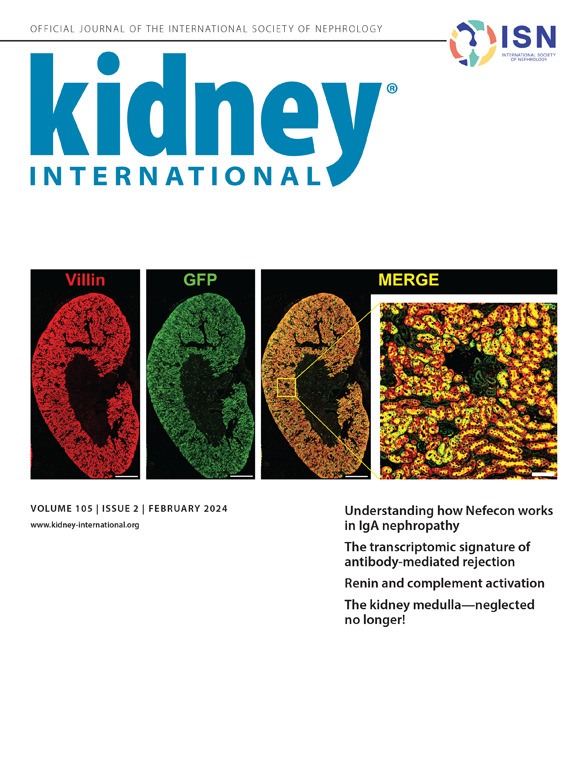微小病变/局灶节段性肾小球硬化中计算衍生小管特征的临床意义及其与间质微环境的空间关系
IF 14.8
1区 医学
Q1 UROLOGY & NEPHROLOGY
引用次数: 0
摘要
背景:小管损伤的视觉评分在捕捉结构变化的全谱和预后潜力方面存在局限性。在这里,我们研究了计算量化的小管特征是否可以增强预后并揭示与间质纤维化的空间关系。方法采用深度学习和图像分析方法,对来自NEPTUNE/CureGN前瞻性观察队列研究参与者(135/153局灶节段性肾小球硬化症(FSGS)和119/113最小变化疾病(MCD))的254/266周期酸希夫染色全切片图像(WSI)肾脏活检进行深度学习和图像分析,以分割皮质、管状管腔(TL)、上皮(TE)、核(TN)和基底膜(TBM)。从这些分节的管状亚结构中提取了104个病理特征,并使用汇总统计在患者水平上进行汇总。在NEPTUNE数据集中,在WSI水平和人工分割的成熟间质纤维化和管状萎缩(IFTA)、预IFTA和非IFTA区域对管状特征进行了量化。然后使用最小冗余最大相关性来选择与疾病进展和蛋白尿缓解最相关的特征。与临床/人口统计数据和视觉评估相比,ridge惩罚Cox模型评估了它们的预测歧视。模型在CureGN数据集中进行评估。结果:snine特征可预测疾病进展和/或蛋白尿缓解。具有管状特征的模型在NEPTUNE和CureGN中都具有较高的预测准确性,并且与在NEPTUNE中单独使用常规参数相比,这两种结果的预测准确性更高。TBM厚度/面积和TE变平和/或细胞大小减小从非IFTA到预成熟IFTA逐渐增加。结论以前未被充分认识的计算衍生和可量化的小管特征可能有助于提高FSGS/MCD患者的预后准确性和风险分层。在将其应用于临床实践之前,需要进一步的研究来测试它们在不同疾病和人群中的普遍性。本文章由计算机程序翻译,如有差异,请以英文原文为准。
Clinical relevance of computationally derived tubular features and their spatial relationships with the interstitial microenvironment in minimal change disease/focal segmental glomerulosclerosis.
BACKGROUND
Visual scoring of tubular damage has limitations in capturing the full spectrum of structural changes and prognostic potential. Here, we investigated if computationally quantified tubular features can enhance prognostication and reveal spatial relationships with interstitial fibrosis.
METHODS
Deep-learning and image-analysis approaches were employed on 254/266 Periodic acid Schiff-stained whole slide image (WSI) kidney biopsies from participants in the NEPTUNE/CureGN prospective observational cohort studies (135/153 with focal segmental glomerulosclerosis (FSGS) and 119/113 with minimal change disease (MCD)) to segment cortex, tubular lumen (TL), epithelium (TE), nuclei (TN), and basement membrane (TBM). One hundred four pathomic features were extracted from these segmented tubular substructures and aggregated at the patient level using summary statistics. In the NEPTUNE dataset, tubular features were quantified at the WSI level and in manually segmented regions of mature interstitial fibrosis and tubular atrophy (IFTA), pre-IFTA, and non-IFTA. Minimum Redundancy Maximum Relevance was then used to select features most associated with disease progression and proteinuria remission. Ridge-penalized Cox models evaluated their predictive discrimination compared to clinical/demographic data and visual-assessment. Models were evaluated in the CureGN dataset.
RESULTS
Nine features were predictive of disease progression and/or proteinuria remission. Models with tubular features had high prognostic accuracy in both NEPTUNE and CureGN, and higher prognostic accuracy for both outcomes compared to conventional parameters alone in NEPTUNE. TBM thickness/area and TE flattening and/or reduced cell size progressively increased from non- to pre- and mature IFTA.
CONCLUSIONS
Previously underrecognized computationally derived and quantifiable tubular characteristics may contribute to improving prognostic accuracy and risk stratification in patients with FSGS/MCD. Future studies are needed to test their generalizability across different diseases and populations before they can be deployed in clinical practice.
求助全文
通过发布文献求助,成功后即可免费获取论文全文。
去求助
来源期刊

Kidney international
医学-泌尿学与肾脏学
CiteScore
23.30
自引率
3.10%
发文量
490
审稿时长
3-6 weeks
期刊介绍:
Kidney International (KI), the official journal of the International Society of Nephrology, is led by Dr. Pierre Ronco (Paris, France) and stands as one of nephrology's most cited and esteemed publications worldwide.
KI provides exceptional benefits for both readers and authors, featuring highly cited original articles, focused reviews, cutting-edge imaging techniques, and lively discussions on controversial topics.
The journal is dedicated to kidney research, serving researchers, clinical investigators, and practicing nephrologists.
 求助内容:
求助内容: 应助结果提醒方式:
应助结果提醒方式:


